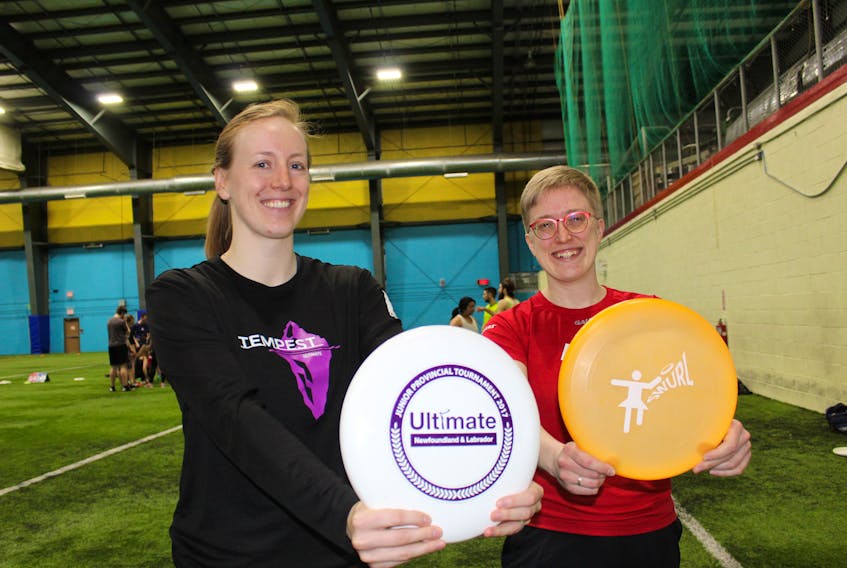ST. JOHN'S, N.L. — Melissa Wheeler has played sports her entire life, but she says gender equity is her “main passion right now.”
She’s played soccer, volleyball, and even attended Canada Games playing basketball.
“When I came to play ultimate, I wasn’t getting the disc, like, at all. I was like, ‘I don’t understand why this is happening.’
“And then I realized … women are typically dismissed right off the bat just because of our genetic makeup. I really took it upon myself then to get better at the sport, so I did everything I could – I practiced all the time, I signed up for everything.”
Today, Wheeler is a captain on a competitive travelling league, she’s president of the St. John’s Women’s Ultimate Recreational League (SWURL) and vice-president of Ultimate NL, an umbrella organization for all ultimate leagues in the province.
She’s also chair of the Gender Equity Committee, where she’s working to make the sport more equitable for all gender identities.
Statistics reveal inequality
“This is an international sport and there have been a lot of research studies done coming out in the last few years that are showing that women don’t get the disc nearly as much as men do, and some of that is because the ratio usually always favours men to women.”
Traditionally, ultimate is played seven-on-seven, with four male-matching players and three female-matching players.

St. John’s leagues use the terms ‘female-matching’ and ‘male-matching’ in order to be inclusive of players who identify as non-binary or transgender. Upon registration, players aren’t asked to tick a box for their gender, rather they are asked who they would feel most comfortable matching up with on the field.
Wheeler said the four-to-three ratio means female-matching players already have a lower percentage chance of getting the disc simply because there’s one less of them on the field.
“There’s a movement definitely within ultimate, and especially here in our local community, that we’re kind of tired of it.”
In Fall 2017, the Gender Equity Committee was formed with representatives from Ultimate NL, SWURL, the mixed league Mile Zero Ultimate (MZU), and the junior female league Storm.
One of the initiatives of the committee was to gather statistics during the mixed league games, which they collected during this winter 2019 season.
They recorded the number of times female-matching players caught the disc, picked up the disc, made an assist or scored a goal.
League teams had three male-matching players and two female-matching players.
“We were hoping to see that if women were 40 per cent of the makeup on the field, we wanted women to be getting at least 40 per cent of the stats in those categories and the stats revealed a much different story.
“The ones that stick out to me is that women only threw 16 per cent of the assists.”
Wheeler said disc pickups were another interesting indicator.
“We were watching men kind of wave women off the disc, like, ‘I’ve got it, I’ve got it’, so we’re trying to empower women to have the confidence to pick up the disc and start the play.”
Changing the statistics
Then the committee collected another set of statistics from a league that began alternating the gender ratios throughout the game.
In that league, for one half of the game, each team would play three male-matching and two female-matching players, and the other half of the game they’d play three female-matching and two male-matching players.
“There was a huge improvement in the stats for female-matching because when you give us an opportunity to play more, then we get to have more disc time and our stats go up … the new stats prove that when women have more time on the field, then they contribute more to a team and they have more of an opportunity to get better and develop their skills," Wheeler explained.
The first league in St. John’s to alternate gender ratios was the MZU fall outdoor league. MZU did it again with a league this past winter season.
"... the new stats prove that when women have more time on the field, then they contribute more to a team and they have more of an opportunity to get better and develop their skills.” — Melissa Wheeler
Wheeler said it’s been a positive step, and MZU plans to continue the practice in the summer.
‘The sport is better for it’
Rosie Myers played ultimate when she was in university, but stopped because she felt there wasn’t a great deal of gender equity.
She’s started playing again and notices a marked improvement in the overall experience with the implementation of the ratio rule.
“I remember our first completely female-matching player point, I was like, ‘Yes!’ It was so exciting. I was moved,” she said.
“You could tell it just really changed the female-matching players on my team of all levels. It just changed the way they saw the game.
“They saw their roles as more important, and it shouldn’t have to take that gender flip to do that, but I think it did.”
Myers said she “definitely won’t be leaving the sport again anytime soon.”
“I’m playing more and more all the time now.”
Twitter: @juanitamercer









